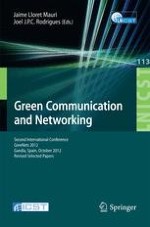2013 | Buch
Green Communication and Networking
Second International Conference, GreeNets 2012, Gandia, Spain, October 25-26, 2012, Revised Selected Papers
herausgegeben von: Jaime Lloret Mauri, Joel J. P. C. Rodrigues
Verlag: Springer Berlin Heidelberg
Buchreihe : Lecture Notes of the Institute for Computer Sciences, Social Informatics and Telecommunications Engineering
